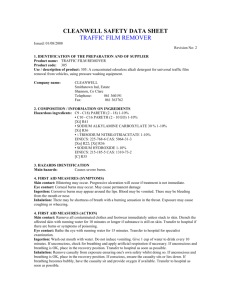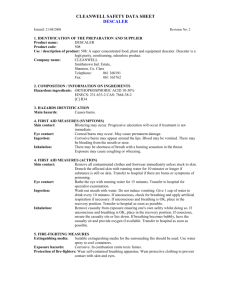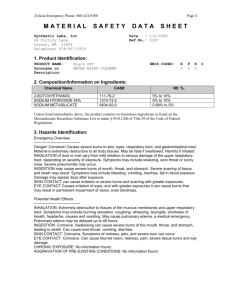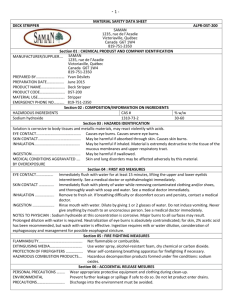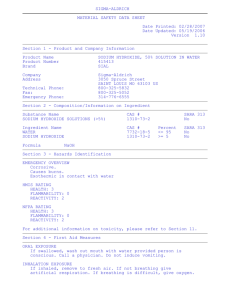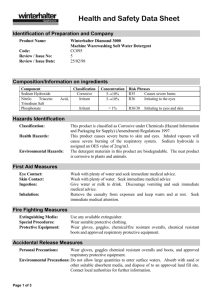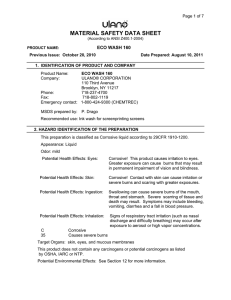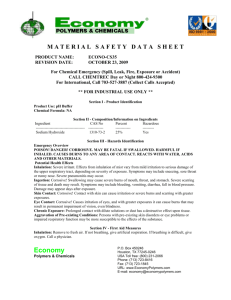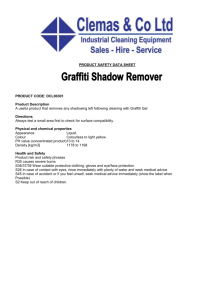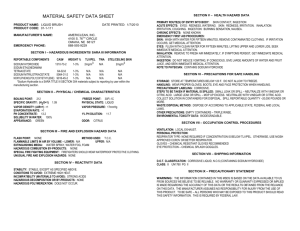Cabinet Glasswash
advertisement
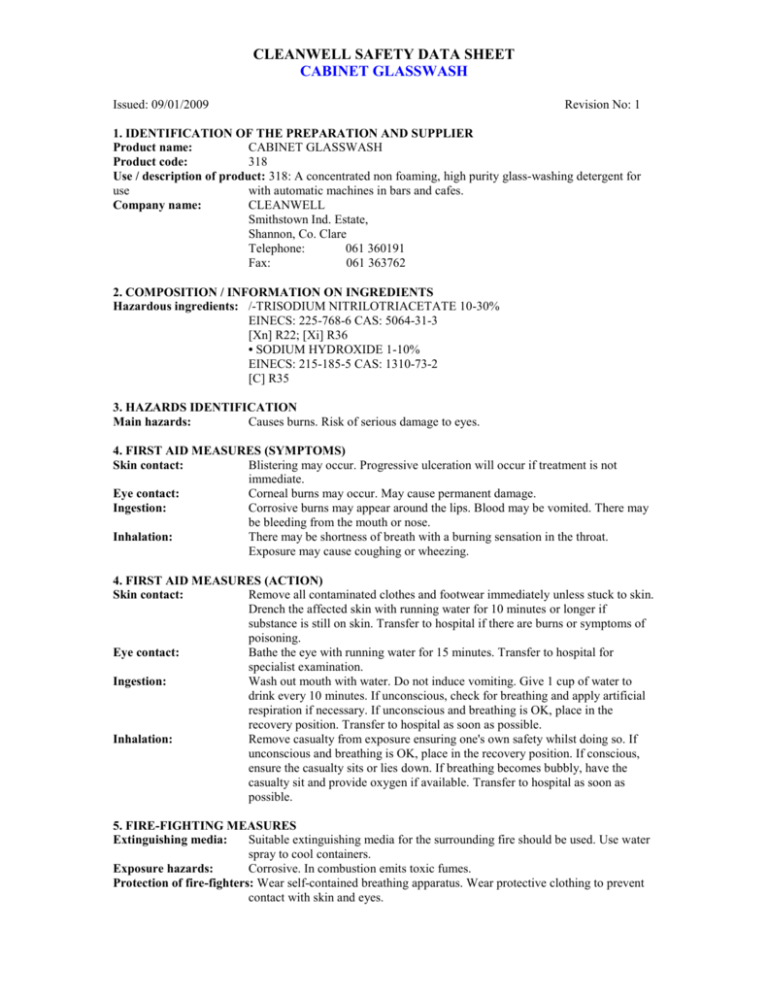
CLEANWELL SAFETY DATA SHEET CABINET GLASSWASH Issued: 09/01/2009 Revision No: 1 1. IDENTIFICATION OF THE PREPARATION AND SUPPLIER Product name: CABINET GLASSWASH Product code: 318 Use / description of product: 318: A concentrated non foaming, high purity glass-washing detergent for use with automatic machines in bars and cafes. Company name: CLEANWELL Smithstown Ind. Estate, Shannon, Co. Clare Telephone: 061 360191 Fax: 061 363762 2. COMPOSITION / INFORMATION ON INGREDIENTS Hazardous ingredients: /-TRISODIUM NITRILOTRIACETATE 10-30% EINECS: 225-768-6 CAS: 5064-31-3 [Xn] R22; [Xi] R36 • SODIUM HYDROXIDE 1-10% EINECS: 215-185-5 CAS: 1310-73-2 [C] R35 3. HAZARDS IDENTIFICATION Main hazards: Causes burns. Risk of serious damage to eyes. 4. FIRST AID MEASURES (SYMPTOMS) Skin contact: Blistering may occur. Progressive ulceration will occur if treatment is not immediate. Eye contact: Corneal burns may occur. May cause permanent damage. Ingestion: Corrosive burns may appear around the lips. Blood may be vomited. There may be bleeding from the mouth or nose. Inhalation: There may be shortness of breath with a burning sensation in the throat. Exposure may cause coughing or wheezing. 4. FIRST AID MEASURES (ACTION) Skin contact: Remove all contaminated clothes and footwear immediately unless stuck to skin. Drench the affected skin with running water for 10 minutes or longer if substance is still on skin. Transfer to hospital if there are burns or symptoms of poisoning. Eye contact: Bathe the eye with running water for 15 minutes. Transfer to hospital for specialist examination. Ingestion: Wash out mouth with water. Do not induce vomiting. Give 1 cup of water to drink every 10 minutes. If unconscious, check for breathing and apply artificial respiration if necessary. If unconscious and breathing is OK, place in the recovery position. Transfer to hospital as soon as possible. Inhalation: Remove casualty from exposure ensuring one's own safety whilst doing so. If unconscious and breathing is OK, place in the recovery position. If conscious, ensure the casualty sits or lies down. If breathing becomes bubbly, have the casualty sit and provide oxygen if available. Transfer to hospital as soon as possible. 5. FIRE-FIGHTING MEASURES Extinguishing media: Suitable extinguishing media for the surrounding fire should be used. Use water spray to cool containers. Exposure hazards: Corrosive. In combustion emits toxic fumes. Protection of fire-fighters: Wear self-contained breathing apparatus. Wear protective clothing to prevent contact with skin and eyes. CLEANWELL SAFETY DATA SHEET CABINET GLASSWASH 6. ACCIDENTAL RELEASE MEASURES Personal precautions: Notify the police and fire brigade immediately. If outside keep bystanders upwind and away from danger point. Mark out the contaminated area with signs and prevent access to unauthorized personnel. Do not attempt to take action without suitable protective clothing - see section 8 of SDS. Turn leaking containers leak-side up to prevent the escape of liquid. Environmental precautions: Do not discharge into drains or rivers. Contain the spillage using bunding. Clean-up procedures: Clean-up should be dealt with only by qualified personnel familiar with the specific substance. Absorb into dry earth or sand. Transfer to a closable, labelled salvage container for disposal by an appropriate method. 7. HANDLING AND STORAGE Handling requirements: Avoid direct contact with the substance. Ensure there is sufficient ventilation of the area. Do not handle in a confined space. Avoid the formation or spread of mists in the air. Storage conditions: Store in cool, well ventilated area. Keep container tightly closed. Suitable packaging: Stainless steel. Teflon. Polyethylene. 8. EXPOSURE CONTROLS / PERSONAL PROTECTION Hazardous ingredients: SODIUM HYDROXIDE WEL (15 min STEL): 2 mg/m3 Engineering measures: Ensure there is sufficient ventilation of the area. Respiratory protection: Self-contained breathing apparatus must be available in case of emergency. Hand protection: Impermeable gloves. Gloves (alkali-resistant) Eye protection: Tightly fitting safety goggles. Ensure eye bath is to hand. Skin protection: Impermeable protective clothing. 9. PHYSICAL AND CHEMICAL PROPERTIES State: Liquid Colour: Yellow Odour: Barely perceptible odour Evaporation rate: Moderate Oxidising: Non-oxidising (by EC criteria) Solubility in water: Soluble Viscosity: Non-viscous Relative density: 1.15 pH: 1% = 12.3 VOC g/l: 0 10. STABILITY AND REACTIVITY Stability: Stable under normal conditions. Conditions to avoid: Heat. Materials to avoid: Strong oxidising agents. Strong acids. Haz. decomp. products: In combustion emits toxic fumes. 11. TOXICOLOGICAL INFORMATION Hazardous ingredients: SODIUM HYDROXIDE IPR MUS LD50 40 mg/kg ORL RBT LDLO 500 mg/kg Routes of exposure: Refer to section 4 of SDS for routes of exposure and corresponding symptoms. 12. ECOLOGICAL INFORMATION Mobility: Readily absorbed into soil. Persistence and degradability: Biodegradable. Bioaccumulative potential: No bioaccumulation potential. Other adverse effects: Negligible ecotoxicity. CLEANWELL SAFETY DATA SHEET CABINET GLASSWASH 13. DISPOSAL CONSIDERATIONS Disposal of packaging: Dispose of as normal industrial waste. NB: The user's attention is drawn to the possible existence of regional or national regulations regarding disposal. 14. TRANSPORT INFORMATION ADR / RID UN no: Packing group: Shipping name: Labelling: 1760 ADR Class: II Classification code: CORROSIVE LIQUID, N.O.S. (SODIUM HYDROXIDE) 8 Hazard ID no: 80 IMDG / IMO UN no: Packing group: Marine pollutant: 1760 II Class: EmS: Labelling: IATA / ICAO UN no: Packing group: Packing instructions: 1760 Class: II Labelling: 808(P&CA); 812(CAO) 8 C9 8 F-A,S-B 8 8 8 15. REGULATORY INFORMATION Hazard symbols: Corrosive. Risk phrases: Safety phrases: R34: Causes burns. R41: Risk of serious damage to eyes. S26: In case of contact with eyes, rinse immediately with plenty of water and seek medical advice. S36/37/39: Wear suitable protective clothing, gloves and eye / face protection. S45: In case of accident or if you feel unwell, seek medical advice immediately (show the label where possible). S2: Keep out of the reach of children. Haz. ingredients (label): /-TRISODIUM NITRILOTRIACETATE; SODIUM HYDROXIDE Seveso II guideline: Water hazard class: No 1 Classification by VwVwS Air emission directive: Amount m%: 0 Note: The regulatory information given above only indicates the principal regulations specifically applicable to the product described in the safety data sheet. The user's attention is drawn to the possible existence of additional provisions which complete these regulations. Refer to all applicable national, international and local regulations or provisions. 16. OTHER INFORMATION Risk phrases used in s.2: R22: Harmful if swallowed. R36: Irritating to eyes. R35: Causes severe burns. Legal disclaimer: The above information is believed to be correct but does not purport to be all inclusive and shall be used only as a guide. This company shall not be held liable for any damage resulting from handling or from contact with the above product.
